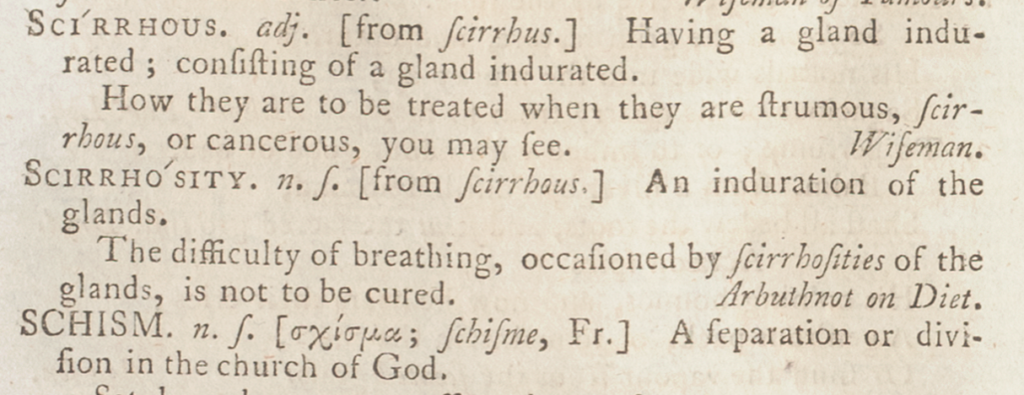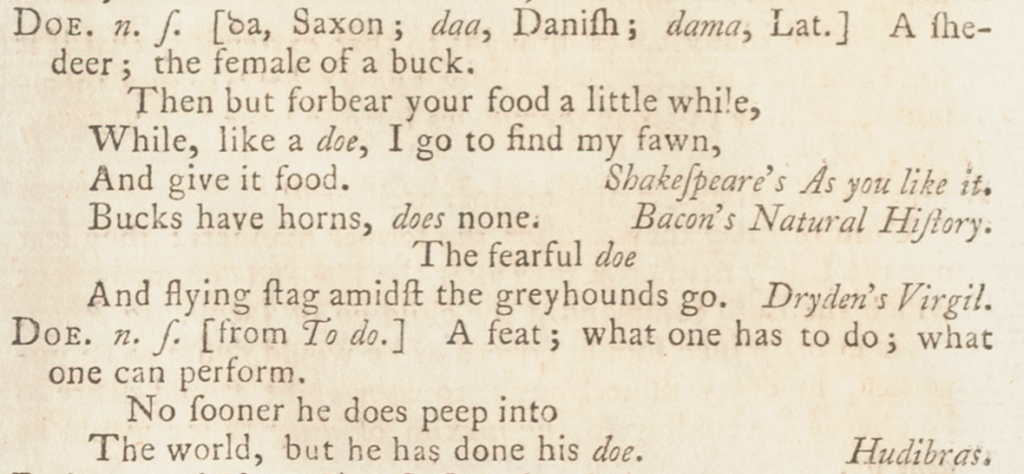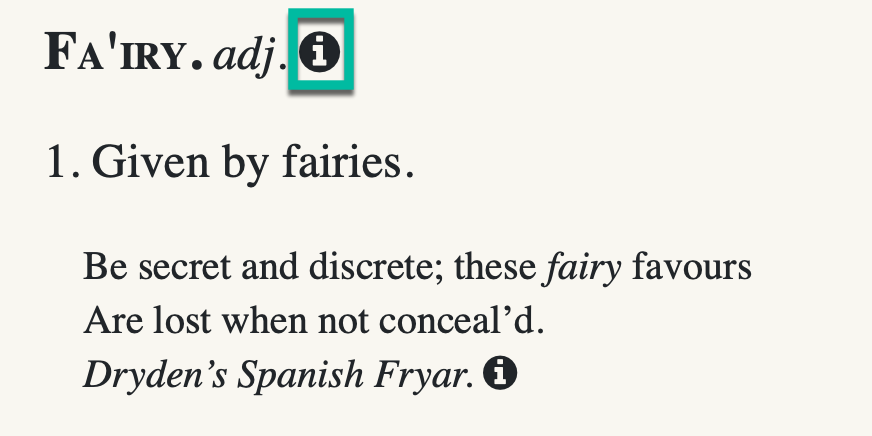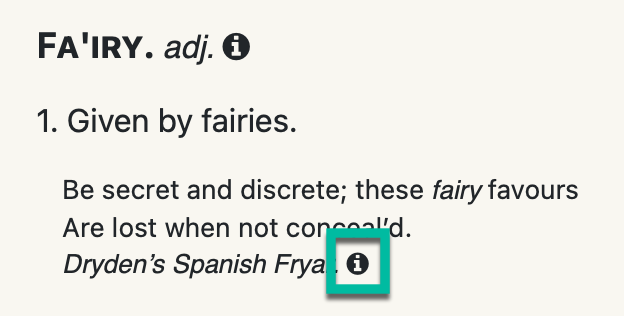Guide to Dictionary
Printed dictionaries fit a great deal of information into a small space using conventions that were pioneered by Johnson’s Dictionary. This guide explains important features of Johnson’s dictionary entries as they appear in the facsimile images and in the transcribed text.
Johnson’s Dictionary Editions
Johnson’s Dictionary Online provides transcriptions of the 1755 edition and the 1773 edition. Our Search page allows the user to expand or narrow their search between the two editions.
1755 Edition
The 1755 edition is the first published edition of Johnson’s Dictionary. Johnson’s two volume dictionary was published on April 15, 1755 in folio format. See About Johnson’s Dictionary for more information on the development of Johnson’s Dictionary.
1773 Edition
The 1773 edition is the fourth edition of Johnson’s Dictionary. This edition followed the publication of two abridged versions of Johnson’s Dictionary. The 1773 folio edition provided significant revisions to Johnson’s dictionary, including new headwords, quotations, and senses. See About Johnson’s Dictionary for more information on the development of Johnson’s Dictionary.
Spelling
Spelling in the 18th century was more variable than modern spelling. Johnson’s Dictionary spells many words, even proper names, in more than one way. Our transcription corrects obvious typographical errors but otherwise preserves Johnson’s spelling.
Standardization of the Letter “S”
One exception is the change from the long “ʃ” character. Johnson’s Dictionary includes the long “ʃ” character, a form of the letter s. Our transcription uses “s” throughout, to make reading and searching the dictionary easier for modern readers. For example, the word “diʃtinct” is transcribed as “distinct” (as shown in the figures below).


Variations in 18th Century Spelling
Our database allows the user to retrieve entries with their modern spelling. For example, the entry for “usquebaugh” can be retrieved via headword search for “whiskey” or “whisky.” Note that spelling variation can also cause variation in alphabetical order (see Variations in Order of Entries for exceptions). For guidance on searching words with variations in spelling, see Use Wildcards to Facilitate Searches.
Alphabetical Order
The 18th century alphabet differed somewhat from our modern alphabet.
In the 18th century, the letters I and J were considered different forms of the same letter; the same with letters U and V. As a result, in Johnson’s Dictionary the word jargon comes before the word idle, and vagabond comes before ultimate.
Entries With Multiple Headwords
Sometimes, Johnson links multiple headwords together to the same definition. In these cases, the word is normally alphabetized by the first headword. For example, the entry shown in the figure below contains the headwords lady-bird, lady-cow, and lady-fly.

Variations in Order of Entries
Sometimes, Johnson’s Dictionary groups words together outside of alphabetical order as shown in the image below. If you can’t find a word where you expect it on a facsimile page, look at the nearby pages.

Headword
The headword is the word being defined. Johnson’s Dictionary lists headwords in alphabetical order, as in a modern dictionary (see Variations in Order of Entries for exceptions).

Sometimes these words are preceded by “to,” “a,” or “the,” a practice that was common in the eighteenth century but does not affect the alphabetical order.
Headword Format
Johnson’s Dictionary displays each headword using all capital letters. See the table below for descriptions of the different headword formats and their variations.
| Headword Format | Description |
| Large Capital Letters |
Headwords in all capital letters represent the standard entry in Johnson’s Dictionary. |
| Small Capital Letters |
Johnson lists headwords that he considered to be derived from another English word in small capital letters. |
| Italicized Capital Letters |
Headwords that Johnson considered to be more foreign than English are italicized. |
Stress
In headwords, Johnson places an accent mark in the syllable that receives the most stress. The accent mark gives information for pronouncing the word, but the mark is not part of the word’s normal spelling. When the word is used within the entry itself, the accent mark does not appear.
Stress is the relative emphasis with which syllables of a word are spoken. Sometimes different parts of speech are distinguished chiefly by which syllable is stressed. Imagine the difference in stress between saying the word “abstract” AB-stract versus saying it ab-STRACT. The following figures show how the last syllable is stressed in the verb “abstract”, while the first syllable is stressed in the noun.


Homograph
Unrelated words can have the same spelling. These identically spelled words are called homographs. Each homograph has its own entry in the dictionary. For example, Johnson provides two entries for two nouns that are spelled “doe” (shown in the following figure). The existence of two entries means that Johnson considered these homographs to be two different words.

Homographs in Search Results
By contrast, Johnson lists different senses (meanings) of the same word under the same headword. For example, the word “dog” has four different senses. The fact that all these senses are contained in the same entry means that Johnson considered “dog” to be one noun with four possible meanings, not four different nouns.
In our search results, homographs are listed separately, distinguished by their parts of speech and (when multiple homographs have the same part of speech) by number.

Part of Speech
A part of speech is the label for a word’s grammatical role, such as noun, verb, etc. To view an entry’s part of speech, click the circled “i” beside the part of speech.

The labels used in the eighteenth century differ somewhat from modern labels. The table below identifies some labels that Johnson’s Dictionary commonly uses, along with their modern equivalents (if different).
| Abbreviation | 18th Century | Modern |
| ad. or adj. | adjective | adjective |
| adv. | adverb | adverb |
| conj. | conjunction | conjunction |
| interj. or interject. | interjection | interjection |
| n.s. | noun substantive | noun |
| prep. or preposition. | preposition | preposition |
| pron. | pronoun | pronoun |
| v.a. | verb active | verb – transitive |
| v.n. | verb neuter | verb – intransitive |
Etymology
Johnson’s Dictionary typically gives a word’s etymology, or ancestry, in square brackets after the part-of-speech label as shown in the following figure.

Most of Johnson’s etymologies list only an etymon (ancestor) or two. Sometimes the etymology is explained elsewhere in the entry and not in brackets as shown in the figure below.

Revisions to Greek and Saxon Etymologies
We transcribe the Greek and Saxon letters in Johnson’s etymologies with their modern equivalents to make reading and searching easier, except that Saxon eth (Ð, ð) and thorn (Þ, þ) (which would now be spelled with two letters, “th”) have been preserved.


Languages
Language names in the 18th century differed somewhat from modern language names. Our transcription retains Johnson’s names; we do not modernize any language names. The table below identifies some of the language names referenced in Johnson’s Dictionary that might confuse readers.
| Language Name | Modern Name |
| Armorick | Old Breton |
| Erse | Irish |
| Frisick | Frisian |
| old English | Middle English |
| Persick | Persian/Farsi |
| Saxon | Old English |
| Teutonick | German |
Usage
Johnson often adds additional context on how words should be used. His usage advice sometimes is set off by square brackets but can show up anywhere in the entry.

The following figure on the left provides an example of a usage description contained within square brackets. The following figure on the right provides an example of additional context appearing in the entry without brackets.

Understanding Johnson’s Usage Terminology
Some of Johnson’s usage terminology had meanings that may be unfamiliar to modern readers. Refer to the table below for a list of Johnson’s usage terminology and their definitions.
| Word | Definition |
| bad | generally disfavored or looked down upon |
| barbarous | impure or unsuited to English |
| cant | specialized jargon |
| country | either rural or uneducated |
| low | undignified; not appropriate for formal writing |
| low Latin | post-classical or medieval Latin |
| ludicrous | funny, not serious |
| rustick | like “country,” either rural or uneducated |
| scarce English | more foreign than English |
| unauthorized | not supported by a respected writer |
Inflected Forms
In English, inflected forms are normally easy to predict. English has comparatively few inflections and many of them are created in a regular manner: for example, we add –s or –es to nouns, -ed and –ing to verbs, -er and –est to adjectives and adverbs. When inflections are less predictable, Johnson sometimes lists them near the beginning of the entry as shown in the following figure.

Senses
Many words, particularly common words, have more than one meaning. Each of these meanings is called a sense, and Johnson, like modern lexicographers, numbers the different senses in each entry.
Transcription Updates to Senses
Occasionally in the print volumes, sense numbers appear out of order. For ease of reference, our transcribed text corrects errors when the intended numbering seems obvious.
Phrasal Verb
A phrasal verb is an idiomatic phrase that is typically made up of a verb plus a preposition or an adverb. Johnson includes these phrases in the entry for the verb. He typically lists these phrasal senses near the end of the entry. For example, in the entry for Set, v.n., the last ten senses define phrases such as to set about, to set in, to set on, to set out, to set up.
Illustrative Quotations
Johnson’s Dictionary illustrates definitions with quotations showing the word in use. These quotations—more than 110,000 of them, drawn from respected writers in diverse fields including agriculture, religion, ship-building, literature, politics, medicine, print-making, history, chemistry, etc.—were considered one of the most valuable features of the folio editions. These quotations are indented in the transcription.
Viewing Quotation Sources
Johnson frequently edited quotations and abbreviated the names of authors and titles that he was quoting. Where possible, our online edition identifies the author and title.
To view information about the author and/or title, click on the circled “i” after the name/title.

Cross-References
To save space in the print edition, Johnson avoided duplicating information. When additional information about one entry can be found in another entry, Johnson’s Dictionary provides a cross-reference to let readers know where to look for it as shown in the following figure.

Viewing Cross-References
Our transcription links Johnson’s cross-references to their respective entry (shown in the figure below). To view the entry, click on the cross reference in our transcription.



